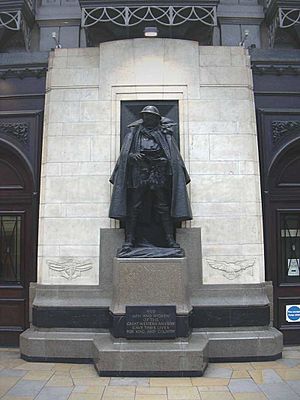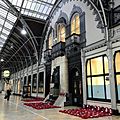Great Western Railway War Memorial facts for kids
Quick facts for kids Great Western Railway War Memorial |
|
|---|---|
| United Kingdom | |
 |
|
| For employees of the Great Western Railway who gave their lives during the First World War | |
| Unveiled | 11 November 1922 |
| Location | 51°31′02″N 0°10′41″W / 51.51713°N 0.178172°W Paddington station, London
|
| Designed by |
|
The Great Western Railway War Memorial is a special monument at London Paddington station. It remembers the brave employees of the Great Western Railway company. These people gave their lives during the First World War. The stone parts of the memorial were designed by an architect named Thomas S. Tait. The bronze soldier statue was made by a sculptor called Charles Sargeant Jagger. The memorial was officially shown to the public on Armistice Day in 1922. This day marks the end of the First World War. Viscount Churchill unveiled it.
Contents
What Does the Memorial Look Like?
The main part of the memorial is a large bronze statue of a British soldier. He is from the First World War. The soldier is wearing his battle gear, including a helmet and a greatcoat. He also has a woollen scarf. The soldier is looking down, reading a letter that looks like it's from home.
On the stone around the statue, you can see two special symbols. One is for the Royal Navy, showing a rope and an anchor. The other is for the Royal Air Force, showing an eagle flying. Inside the base of the memorial, there is a sealed box. This box was made at the GWR's Swindon Works. It holds a special scroll with the names of 2,524 men who died.
A Similar Statue and Other Projects
In 1982, a life-size statue similar to the GWR War Memorial was made. It was called Letter from Home. This statue was created by Jill Tweed and Mike Smith. It was made to celebrate the founding of the Army Post Office Corps. Queen Elizabeth II unveiled this statue at Inglis Barracks in London. Later, in 2007, the statue was moved to RAF Northolt.
In 2014, the GWR Memorial was part of two special projects. These projects helped remember the First World War 100 years later. One project was called "Letter to an Unknown Soldier." People were asked to write a letter to the soldier in the statue. The memorial also featured in the "Talking Statues" project that year.
What Do the Inscriptions Say?
The words carved on the base of the memorial say:
IN HONOUR OF THOSE WHO SERVED IN THE WORLD WARS
1914 † 1918 1939 † 1945 3312 MEN AND WOMEN OF THE GREAT WESTERN RAILWAY GAVE THEIR LIVES FOR KING AND COUNTRY. THE NAMES OF THOSE WHO GAVE THEIR LIVES ARE INSCRIBED ON A ROLL OF HONOUR DEPOSITED BENEATH THE BRONZE FIGURE.
This inscription honors those who served in both the First and Second World Wars. It states that 3,312 men and women from the Great Western Railway died for their country. Their names are on a special scroll inside the memorial.
Inside the waiting room behind the memorial, there is another plaque. It tells about the memorial's unveiling. It says:
THE GREAT WESTERN RAILWAY WAR MEMORIAL
ON PLATFORM No 1 IMMEDIATELY OUTSIDE THIS ROOM WAS UNVEILED ON ARMISTICE DAY, SATURDAY, NOVEMBER 11TH 1922
BY THE RT. HON VISCOUNT CHURCHILL, G.C.V.O. AND DEDICATED BY HIS GRACE THE ARCHBISHOP OF CANTERBURY.
THE BRONZE FIGURE WAS EXECUTED BY MR. C.S. JAGGER, M.C., R.B.S. AND THE ARCHITECTURAL WORK BY MR. T.S.TAIT A.R.I.B.A.
This plaque explains that the memorial was unveiled on Platform 1 on November 11, 1922. It mentions that Viscount Churchill unveiled it and the Archbishop of Canterbury dedicated it. It also credits C.S. Jagger for the bronze figure and T.S. Tait for the architectural design.
Images for kids
-
One of Jagger's figures on the Royal Artillery Memorial. Jagger was known for the realism of the soldiers he sculpted.







